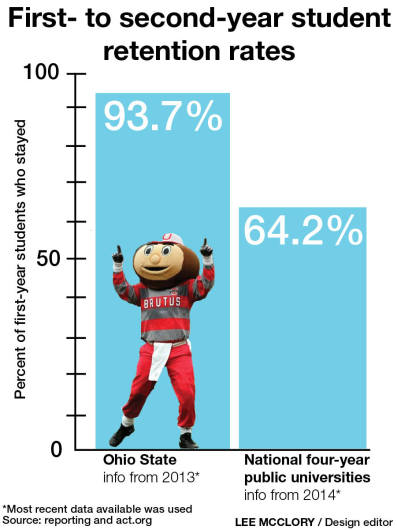More than 90 percent of students are deciding to stay at Ohio State after completing their first year of school, about 46 percent higher than the average national retention rate.
OSU boasts a first- to second-year retention rate of 93.7 percent for students who started school in fall 2013, said Bernie Savarese, director of First Year Experience.
Only 2 percent transfer after the first semester and an additional 4-5 percent leave the university after their second semester, Savarese added.
The average national retention rate for four-year public institutions is 64.2 percent, according to the 2014 ACT Institutional Data Questionnaire.
Some students choose to leave OSU after the first semester because of financial or other personal challenges, but most usually make the decision to leave after the first year, causing the difference between first- and second-semester retention rates, Savarese said.
OSU’s First Year Experience is working to make students’ first year at OSU better through programs like First Year Success Series, Buckeye Book Community and a university survey course, Savarese said.
“I like to think of the Success Series as a resource aggregator that shrinks the campus and expedites connections for new students,” he said.
The First Year Success Series program requires first-year students to attend a set number of informational sessions during Fall Semester as a requirement for their survey classes.
This past fall, First Year Experience offered about 500 class sessions with themes such as academic success and career exploration, finances, and diversity and global awareness, Savarese said. These programs aim to help students adjust to their first year at OSU.
Sharon Glenn, a first-year in exploration, attended a Buckeye Book Community session and a session on how to achieve success after a class’s first midterm.
“I think the sessions were helpful in making students aware of the resources on campus that we might not have been aware of otherwise,” Glenn said.
In the first semester, First Year Experience is set to also provide peer leaders to mentor first-year students.
The peer leaders will also do a special outreach to populations based on research and experience, Savarese said. Those groups include first-generation college students, out-of-state students and transfer students.
“These students coming into the university have lots of questions and anxiety, and being able to talk to an upper-class student who has already been through what they’ve experienced can be really powerful,” said Nicole Craven, assistant director of First Year Experience.
Peer leaders will have the opportunity to not only be first-year student orientation leaders, but also reach out to various students and help them make the connections they need within the university.
Although OSU is above this average retention rate, Savarese said he still thinks there is more that could be done.
“The answer may be in doing more to proactively identify and intervene with new students who are either less likely to be successful or students who are showing warning signs during their first year,” he said. “I would argue that we can’t wait until after the first semester is over to take action.”



